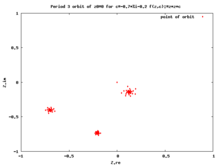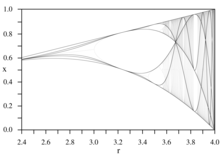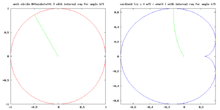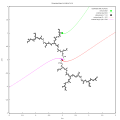A complex quadratic polynomial is a quadratic polynomial whose coefficients and variable are complex numbers .
Properties
Quadratic polynomials have the following properties, regardless of the form:
It is a unicritical polynomial, i.e. it has one finite critical point in the complex plane, Dynamical plane consist of maximally 2 basins: basin of infinity and basin of finite critical point ( if finite critical point do not escapes)
It can be postcritically finite , i.e. the orbit of the critical point can be finite, because the critical point is periodic or preperiodic.[ 1]
It is a unimodal function ,
It is a rational function ,
It is an entire function .
When the quadratic polynomial has only one variable (univariate ), one can distinguish its four main forms:
The general form:
f
(
x
)
=
a
2
x
2
+
a
1
x
+
a
0
{\displaystyle f(x)=a_{2}x^{2}+a_{1}x+a_{0}}
a
2
≠
0
{\displaystyle a_{2}\neq 0}
The factored form used for the logistic map :
f
r
(
x
)
=
r
x
(
1
−
x
)
{\displaystyle f_{r}(x)=rx(1-x)}
f
θ
(
x
)
=
x
2
+
λ
x
{\displaystyle f_{\theta }(x)=x^{2}+\lambda x}
fixed point with multiplier
λ
=
e
2
π
θ
i
{\displaystyle \lambda =e^{2\pi \theta i}}
origin [ 2] The monic and centered form,
f
c
(
x
)
=
x
2
+
c
{\displaystyle f_{c}(x)=x^{2}+c}
The monic and centered form has been studied extensively, and has the following properties:
The lambda form
f
λ
(
z
)
=
z
2
+
λ
z
{\displaystyle f_{\lambda }(z)=z^{2}+\lambda z}
the simplest non-trivial perturbation of unperturbated system
z
↦
λ
z
{\displaystyle z\mapsto \lambda z}
"the first family of dynamical systems in which explicit necessary and sufficient conditions are known for when a small divisor problem is stable"[ 4]
Conjugation
Since
f
c
(
x
)
{\displaystyle f_{c}(x)}
affine conjugate to the general form of the quadratic polynomial it is often used to study complex dynamics and to create images of Mandelbrot , Julia and Fatou sets .
When one wants change from
θ
{\displaystyle \theta }
c
{\displaystyle c}
[ 2]
c
=
c
(
θ
)
=
e
2
π
θ
i
2
(
1
−
e
2
π
θ
i
2
)
.
{\displaystyle c=c(\theta )={\frac {e^{2\pi \theta i}}{2}}\left(1-{\frac {e^{2\pi \theta i}}{2}}\right).}
When one wants change from
r
{\displaystyle r}
c
{\displaystyle c}
[ 5]
c
=
c
(
r
)
=
1
−
(
r
−
1
)
2
4
=
−
r
2
(
r
−
2
2
)
{\displaystyle c=c(r)={\frac {1-(r-1)^{2}}{4}}=-{\frac {r}{2}}\left({\frac {r-2}{2}}\right)}
and the transformation between the variables in
z
t
+
1
=
z
t
2
+
c
{\displaystyle z_{t+1}=z_{t}^{2}+c}
x
t
+
1
=
r
x
t
(
1
−
x
t
)
{\displaystyle x_{t+1}=rx_{t}(1-x_{t})}
z
=
r
(
1
2
−
x
)
.
{\displaystyle z=r\left({\frac {1}{2}}-x\right).}
With doubling map
There is semi-conjugacy between the dyadic transformation (the doubling map) and the quadratic polynomial case of c = –2.
Notation
Iteration
Here
f
n
{\displaystyle f^{n}}
n -th iterate of the function
f
{\displaystyle f}
f
c
n
(
z
)
=
f
c
1
(
f
c
n
−
1
(
z
)
)
{\displaystyle f_{c}^{n}(z)=f_{c}^{1}(f_{c}^{n-1}(z))}
so
z
n
=
f
c
n
(
z
0
)
.
{\displaystyle z_{n}=f_{c}^{n}(z_{0}).}
Because of the possible confusion with exponentiation, some authors write
f
∘
n
{\displaystyle f^{\circ n}}
n th iterate of
f
{\displaystyle f}
Parameter
The monic and centered form
f
c
(
x
)
=
x
2
+
c
{\displaystyle f_{c}(x)=x^{2}+c}
the parameter
c
{\displaystyle c}
the external angle
θ
{\displaystyle \theta }
at c in Mandelbrot set on the parameter plane
on the critical value:z = c in Julia set on the dynamic plane so :
f
c
=
f
θ
{\displaystyle f_{c}=f_{\theta }}
c
=
c
(
θ
)
{\displaystyle c=c({\theta })}
Examples:
c is the landing point of the 1/6 external ray of the Mandelbrot set , and is
z
→
z
2
+
i
{\displaystyle z\to z^{2}+i}
c is the landing point the 5/14 external ray and is
z
→
z
2
+
c
{\displaystyle z\to z^{2}+c}
c
=
−
1.23922555538957
+
0.412602181602004
∗
i
{\displaystyle c=-1.23922555538957+0.412602181602004*i}
Map
The monic and centered form, sometimes called the Douady-Hubbard family of quadratic polynomials ,[ 6]
z
{\displaystyle z}
parameter
c
{\displaystyle c}
f
c
(
z
)
=
z
2
+
c
.
{\displaystyle f_{c}(z)=z^{2}+c.}
When it is used as an evolution function of the discrete nonlinear dynamical system
z
n
+
1
=
f
c
(
z
n
)
{\displaystyle z_{n+1}=f_{c}(z_{n})}
it is named the quadratic map [ 7]
f
c
:
z
→
z
2
+
c
.
{\displaystyle f_{c}:z\to z^{2}+c.}
The Mandelbrot set is the set of values of the parameter c for which the initial condition z 0 = 0 does not cause the iterates to diverge to infinity.
Critical items
Critical points
complex plane
A critical point
f
c
{\displaystyle f_{c}}
z
c
r
{\displaystyle z_{cr}}
the dynamical plane such that the derivative vanishes:
f
c
′
(
z
c
r
)
=
0.
{\displaystyle f_{c}'(z_{cr})=0.}
Since
f
c
′
(
z
)
=
d
d
z
f
c
(
z
)
=
2
z
{\displaystyle f_{c}'(z)={\frac {d}{dz}}f_{c}(z)=2z}
implies
z
c
r
=
0
,
{\displaystyle z_{cr}=0,}
we see that the only (finite) critical point of
f
c
{\displaystyle f_{c}}
z
c
r
=
0
{\displaystyle z_{cr}=0}
z
0
{\displaystyle z_{0}}
Mandelbrot set iteration.[ 8]
For the quadratic family
f
c
(
z
)
=
z
2
+
c
{\displaystyle f_{c}(z)=z^{2}+c}
center of symmetry of the Julia set Jc, so it is a convex combination of two points in Jc.[ 9]
Extended complex plane
In the Riemann sphere polynomial has 2d-2 critical points. Here zero and infinity are critical points.
Critical value
A critical value
z
c
v
{\displaystyle z_{cv}}
f
c
{\displaystyle f_{c}}
z
c
v
=
f
c
(
z
c
r
)
{\displaystyle z_{cv}=f_{c}(z_{cr})}
Since
z
c
r
=
0
{\displaystyle z_{cr}=0}
we have
z
c
v
=
c
{\displaystyle z_{cv}=c}
So the parameter
c
{\displaystyle c}
f
c
(
z
)
{\displaystyle f_{c}(z)}
Critical level curves
A critical level curve the level curve which contain critical point. It acts as a sort of skeleton[ 10]
Example : level curves cross at saddle point , which is a special type of critical point.
Critical limit set
Critical limit set is the set of forward orbit of all critical points
Critical orbit
Dynamical plane with critical orbit falling into 3-period cycle Dynamical plane with Julia set and critical orbit. Dynamical plane : changes of critical orbit along internal ray of main cardioid for angle 1/6 Critical orbit tending to weakly attracting fixed point with abs(multiplier) = 0.99993612384259 The forward orbit of a critical point is called a critical orbit . Critical orbits are very important because every attracting periodic orbit attracts a critical point, so studying the critical orbits helps us understand the dynamics in the Fatou set .[ 11] [ 12] [ 13]
z
0
=
z
c
r
=
0
{\displaystyle z_{0}=z_{cr}=0}
z
1
=
f
c
(
z
0
)
=
c
{\displaystyle z_{1}=f_{c}(z_{0})=c}
z
2
=
f
c
(
z
1
)
=
c
2
+
c
{\displaystyle z_{2}=f_{c}(z_{1})=c^{2}+c}
z
3
=
f
c
(
z
2
)
=
(
c
2
+
c
)
2
+
c
{\displaystyle z_{3}=f_{c}(z_{2})=(c^{2}+c)^{2}+c}
⋮
{\displaystyle \ \vdots }
This orbit falls into an attracting periodic cycle if one exists.
Critical sector
The critical sector is a sector of the dynamical plane containing the critical point.
Critical set
Critical set is a set of critical points
Critical polynomial
P
n
(
c
)
=
f
c
n
(
z
c
r
)
=
f
c
n
(
0
)
{\displaystyle P_{n}(c)=f_{c}^{n}(z_{cr})=f_{c}^{n}(0)}
so
P
0
(
c
)
=
0
{\displaystyle P_{0}(c)=0}
P
1
(
c
)
=
c
{\displaystyle P_{1}(c)=c}
P
2
(
c
)
=
c
2
+
c
{\displaystyle P_{2}(c)=c^{2}+c}
P
3
(
c
)
=
(
c
2
+
c
)
2
+
c
{\displaystyle P_{3}(c)=(c^{2}+c)^{2}+c}
These polynomials are used for:
finding centers of these Mandelbrot set components of period n . Centers are roots of n -th critical polynomials
centers
=
{
c
:
P
n
(
c
)
=
0
}
{\displaystyle {\text{centers}}=\{c:P_{n}(c)=0\}}
M
n
,
k
=
{
c
:
P
k
(
c
)
=
P
k
+
n
(
c
)
}
{\displaystyle M_{n,k}=\{c:P_{k}(c)=P_{k+n}(c)\}}
Critical curves
Critical curves Diagrams of critical polynomials are called critical curves .[ 14]
These curves create the skeleton (the dark lines) of a bifurcation diagram .[ 15] [ 16]
4D space
One can use the Julia-Mandelbrot 4-dimensional (4D) space for a global analysis of this dynamical system.[ 17]
w -plane and c -planeIn this space there are two basic types of 2D planes:
the dynamical (dynamic) plane,
f
c
{\displaystyle f_{c}}
c -plane
the parameter plane or z -plane There is also another plane used to analyze such dynamical systems w -plane
the conjugation plane[ 18]
model plane[ 19]
2D Parameter plane
The phase space of a quadratic map is called its parameter plane . Here:
z
0
=
z
c
r
{\displaystyle z_{0}=z_{cr}}
c
{\displaystyle c}
There is no dynamics here. It is only a set of parameter values. There are no orbits on the parameter plane.
The parameter plane consists of:
There are many different subtypes of the parameter plane.[ 21] [ 22]
Multiplier map See also :
Boettcher map which maps exterior of Mandelbrot set to the exterior of unit discmultiplier map which maps interior of hyperbolic component of Mandelbrot set to the interior of unit disc
2D Dynamical plane
"The polynomial Pc maps each dynamical ray to another ray doubling the angle (which we measure in full turns, i.e. 0 = 1 = 2π rad = 360°), and the dynamical rays of any polynomial "look like straight rays" near infinity. This allows us to study the Mandelbrot and Julia sets combinatorially, replacing the dynamical plane by the unit circle, rays by angles, and the quadratic polynomial by the doubling modulo one map." Virpi Kauko[ 23]
On the dynamical plane one can find:
The dynamical plane consists of:
Here,
c
{\displaystyle c}
z
{\displaystyle z}
The two-dimensional dynamical plane can be treated as a Poincaré cross-section of three-dimensional space of continuous dynamical system.[ 24] [ 25]
Dynamical z -planes can be divided into two groups:
f
0
{\displaystyle f_{0}}
c
=
0
{\displaystyle c=0}
complex squaring map )
f
c
{\displaystyle f_{c}}
c
≠
0
{\displaystyle c\neq 0}
Riemann sphere
The extended complex plane plus a point at infinity
Derivatives
First derivative with respect to c
On the parameter plane:
c
{\displaystyle c}
z
0
=
0
{\displaystyle z_{0}=0}
The first derivative of
f
c
n
(
z
0
)
{\displaystyle f_{c}^{n}(z_{0})}
c is
z
n
′
=
d
d
c
f
c
n
(
z
0
)
.
{\displaystyle z_{n}'={\frac {d}{dc}}f_{c}^{n}(z_{0}).}
This derivative can be found by iteration starting with
z
0
′
=
d
d
c
f
c
0
(
z
0
)
=
1
{\displaystyle z_{0}'={\frac {d}{dc}}f_{c}^{0}(z_{0})=1}
and then replacing at every consecutive step
z
n
+
1
′
=
d
d
c
f
c
n
+
1
(
z
0
)
=
2
⋅
f
c
n
(
z
)
⋅
d
d
c
f
c
n
(
z
0
)
+
1
=
2
⋅
z
n
⋅
z
n
′
+
1.
{\displaystyle z_{n+1}'={\frac {d}{dc}}f_{c}^{n+1}(z_{0})=2\cdot {}f_{c}^{n}(z)\cdot {\frac {d}{dc}}f_{c}^{n}(z_{0})+1=2\cdot z_{n}\cdot z_{n}'+1.}
This can easily be verified by using the chain rule for the derivative.
This derivative is used in the distance estimation method for drawing a Mandelbrot set .
First derivative with respect to z
On the dynamical plane:
z
{\displaystyle z}
c
{\displaystyle c}
At a fixed point
z
0
{\displaystyle z_{0}}
f
c
′
(
z
0
)
=
d
d
z
f
c
(
z
0
)
=
2
z
0
.
{\displaystyle f_{c}'(z_{0})={\frac {d}{dz}}f_{c}(z_{0})=2z_{0}.}
At a periodic point z 0 of period p the first derivative of a function
(
f
c
p
)
′
(
z
0
)
=
d
d
z
f
c
p
(
z
0
)
=
∏
i
=
0
p
−
1
f
c
′
(
z
i
)
=
2
p
∏
i
=
0
p
−
1
z
i
=
λ
{\displaystyle (f_{c}^{p})'(z_{0})={\frac {d}{dz}}f_{c}^{p}(z_{0})=\prod _{i=0}^{p-1}f_{c}'(z_{i})=2^{p}\prod _{i=0}^{p-1}z_{i}=\lambda }
is often represented by
λ
{\displaystyle \lambda }
logarithm is known as the Lyapunov exponent. Absolute value of multiplier is used to check the stability of periodic (also fixed) points .
At a nonperiodic point , the derivative, denoted by
z
n
′
{\displaystyle z'_{n}}
iteration starting with
z
0
′
=
1
,
{\displaystyle z'_{0}=1,}
and then using
z
n
′
=
2
∗
z
n
−
1
∗
z
n
−
1
′
.
{\displaystyle z'_{n}=2*z_{n-1}*z'_{n-1}.}
This derivative is used for computing the external distance to the Julia set.
Schwarzian derivative
The Schwarzian derivative (SD for short) of f is:[ 26]
(
S
f
)
(
z
)
=
f
‴
(
z
)
f
′
(
z
)
−
3
2
(
f
″
(
z
)
f
′
(
z
)
)
2
.
{\displaystyle (Sf)(z)={\frac {f'''(z)}{f'(z)}}-{\frac {3}{2}}\left({\frac {f''(z)}{f'(z)}}\right)^{2}.}
See also
References
^ Poirier, Alfredo (1993). "On postcritically finite polynomials, part 1: Critical portraits". arXiv :math/9305207 ^ a b "Michael Yampolsky, Saeed Zakeri : Mating Siegel quadratic polynomials" (PDF) .^ Bodil Branner : Holomorphic dynamical systems in the complex plane. Mat-Report No 1996-42. Technical University of Denmark^ Dynamical Systems and Small Divisors, Editors: Stefano Marmi, Jean-Christophe Yoccoz, page 46
^ "Show that the familiar logistic map $x_{n+1} = sx_n(1 - x_n)$, can be recoded into the form $x_{n+1} = x_n^2 + c$" . Mathematics Stack Exchange .^ Yunping Jing : Local connectivity of the Mandelbrot set at certain infinitely renormalizable points Complex Dynamics and Related Topics, New Studies in Advanced Mathematics, 2004, The International Press, 236-264^ Weisstein, Eric W. "Quadratic Map" . mathworld.wolfram.com . ^ Java program by Dieter Röß showing result of changing initial point of Mandelbrot iterations Archived 26 April 2012 at the Wayback Machine ^ "Convex Julia sets" . MathOverflow .^ Richards, Trevor (11 May 2015). "Conformal equivalence of analytic functions on compact sets". arXiv :1505.02671v1 math.CV ]. ^ M. Romera Archived 22 June 2008 at the Wayback Machine , G. Pastor Archived 1 May 2008 at the Wayback Machine , and F. Montoya : Multifurcations in nonhyperbolic fixed points of the Mandelbrot map. Archived 11 December 2009 at the Wayback Machine Fractalia Archived 19 September 2008 at the Wayback Machine 6, No. 21, 10-12 (1997)^ Burns A M : Plotting the Escape: An Animation of Parabolic Bifurcations in the Mandelbrot Set. Mathematics Magazine, Vol. 75, No. 2 (Apr., 2002), pp. 104–116^ "Khan Academy" . Khan Academy .^ The Road to Chaos is Filled with Polynomial Curves
by Richard D. Neidinger and R. John Annen III. American Mathematical Monthly, Vol. 103, No. 8, October 1996, pp. 640–653
^ Hao, Bailin (1989). Elementary Symbolic Dynamics and Chaos in Dissipative Systems World Scientific . ISBN 9971-5-0682-3 the original on 5 December 2009. Retrieved 2 December 2009 .^ "M. Romera, G. Pastor and F. Montoya, "Misiurewicz points in one-dimensional quadratic maps", Physica A, 232 (1996), 517-535. Preprint" (PDF) . Archived from the original (PDF) on 2 October 2006.^ "Julia-Mandelbrot Space, Mu-Ency at MROB" . www.mrob.com .^ Carleson, Lennart, Gamelin, Theodore W.: Complex Dynamics Series: Universitext, Subseries: Universitext: Tracts in Mathematics, 1st ed. 1993. Corr. 2nd printing, 1996, IX, 192 p. 28 illus., ISBN 978-0-387-97942-7
^ Holomorphic motions and puzzels by P Roesch
^ Rempe, Lasse; Schleicher, Dierk (12 May 2008). "Bifurcation Loci of Exponential Maps and Quadratic Polynomials: Local Connectivity, Triviality of Fibers, and Density of Hyperbolicity". arXiv :0805.1658 math.DS ]. ^ "Julia and Mandelbrot sets, alternate planes" . aleph0.clarku.edu .^ "Exponential Map, Mu-Ency at MROB" . mrob.com .^ Trees of visible components in the Mandelbrot set by Virpi K a u k o , FUNDAM E N TA MATHEMATICAE 164 (2000) ^ "The Mandelbrot Set is named after mathematician Benoit B" . www.sgtnd.narod.ru .^ Moehlis, Kresimir Josic, Eric T. Shea-Brown (2006) Periodic orbit. Scholarpedia ,^ "Lecture Notes | Mathematical Exposition | Mathematics" . MIT OpenCourseWare .
External links
Concepts
Theoretical Chaoticlist )
Physical Chaos Related


























































































